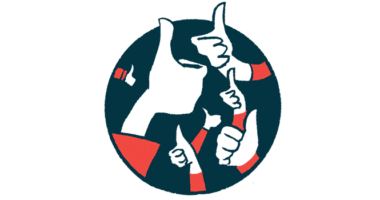Clinical Efficacy of Soliris Supported by Pharmacological Analysis

An analysis of pharmacological data supports the observed clinical efficacy of Soliris (eculizumab) in significantly reducing relapses in patients with neuromyelitis optica spectrum disorder (NMOSD) given the therapy in the PREVENT Phase 3 clinical trial.
At its approved dose, Soliris led to rapid, sustained, and complete suppression of the complement system — which is involved in NMOSD — in patients with antibodies against the protein aquaporin-4 (AQP4-IgG).
In addition, the data suggested that dosing adjustments to maintain a favorable benefit-risk profile are unnecessary for specific patient populations, including those who have kidney/liver impairment, are overweight, or are Asian or Japanese.
The study, “Eculizumab Pharmacokinetics and Pharmacodynamics in Patients With Neuromyelitis Optica Spectrum Disorder,” was published in the journal Frontiers in Neurology. The study was funded by Alexion Pharmaceuticals, which developed Soliris.
In NMOSD, the immune system wrongly produces antibodies that attack proteins in cells that support the nervous system, causing inflammation in the optic nerve and spinal cord. These immune attacks most commonly involve antibodies against the aquaporin-4 (AQP4) water channel protein.
Soliris is approved in the U.S. and other countries for adults with NMOSD who are positive for anti-AQP4 antibodies.
Administered directly into the bloodstream, the therapy works by blocking C5, a complement system protein involved in the immune and inflammatory reactions that drive nerve damage in NMOSD. The complement system is a set of blood proteins that are part of the immune system’s first line of defense.
Given that C5 is a terminal component of the complement system, upstream components are not targeted by Soliris, leaving some of complement’s immune functions intact.
The therapy is given at a recommended dose of 900 mg weekly for the first four doses, followed by 1,200 mg one week later and every other week thereafter.
Soliris’ safety and effectiveness was established in the PREVENT Phase 3 trial (NCT01892345), which tested the therapy against a placebo in 143 adults with NMOSD who were positive for anti-AQP4 antibodies.
In the new analysis, researchers in the U.S. and the Netherlands analyzed PREVENT data to further characterize Soliris’ pharmacokinetics (movement into, through, and out of the body) and pharmacodynamics (effects on the body) in these patients.
This type of information could help confirm the rationale, safety, and effectiveness of the therapy’s approved dose regimen for this indication.
The analysis included data from the 95 participants who received the approved regimen and who had available pharmacological data. Most were white, 37 were Asian, and nine were Japanese.
Results showed that patients achieved steady-state Soliris levels in the blood after four weeks and that therapeutic levels for complete terminal complement suppression were maintained throughout the treatment period (about three years) in 89% of patients.
The blood samples of six of the 10 patients who at any time showed lower-than-target Soliris levels were collected following a delay in the therapy’s scheduled administration.
Also, at any timepoint of the treatment period, 97%–100% of patients with available data had blood C5 levels lower than 0.5 micrograms per milliliter (mcg/ml) — reflecting complete suppression of terminal complement.
This was consistent with the detection of therapeutic Soliris levels in the blood of 92%–100% of patients at any time point.
Complete complement block was achieved by the end of the first Soliris infusion and was sustained throughout the entire treatment period in 96% of patients.
In the remaining patients, target low C5 levels were detected for most samples during the treatment’s maintenance phase, except for one patient who consistently showed levels higher than 0.5 mcg/ml for all available samples for about eight months.
These findings highlight that the Soliris exposure range achieved in these patients effectively reduced blood C5 levels below the 0.5 mcg/ml threshold for complete suppression of terminal complement.
Also, “clinical efficacy was consistent across the range of steady-state [blood Soliris levels] achieved in individual patients, confirming that the recommended dose has been optimized,” the researchers wrote.
Complete complement suppression was also achieved in the three Soliris-treated patients who experienced relapses during the trial, “suggesting that other factor(s) may have triggered the relapse,” they added.
While body weight affected some pharmacokinetic parameters, “the data suggest that no dose adjustments are needed in overweight patients,” the researchers wrote.
No other potential influencing factor affected Soliris pharmacokinetics, indicating that dose adjustments in specific populations, such as Asian or Japanese patients and those with kidney/liver impairment, “are unnecessary to maintain a favorable benefit–risk profile in patients with NMOSD,” they added.
Antibodies against Soliris were detected in blood samples from two patients, but these levels were low and became absent in subsequent samples. In addition, “there was no impact on observed pharmacokinetic/pharmacodynamic data in either patient, and neither patient experienced relapse of NMOSD,” the team wrote.
No differences in safety outcomes were detected across the range of Soliris exposure, further supporting the therapy’s safety.
These findings endorse the recommended dose regimen, with Soliris treatment resulting in “rapid, complete, sustained, and well-tolerated [suppression] of terminal complement activation in these patients, which translates to the significant reduction of NMOSD relapses,” the researchers wrote.
The data also verified “the association between [Soliris’] mechanism of action and the efficacy demonstrated in clinical studies,” they concluded.








